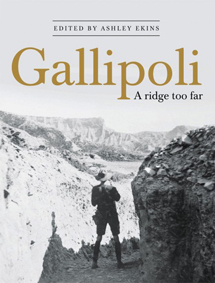Gallipoli: A ridge too far
The story of the landings on Gallipoli on 25 April 1915 is a familiar one to Australians, commemorated each year on the anniversary and revered as a nation-building event. Yet much of the Gallipoli campaign – and in particular the major battles that took place in August – is not understood. In a new book, a group of distinguished international historians set to challenge some of the long-held misconceptions of the campaign by presenting fresh insights into that pivotal offensive.
“In Australia we focus on Anzac Day and the battles of Anzac Day, but the major battles of the campaign were really in August, when the allies made a last ditch effort to break the deadlock that had lasted since the landing,” says Ashley Ekins, editor of Gallipoli: A ridge too far.
“They brought in five fresh divisions from Britain and new troops from Australia. But every single attack resulted in heartbreak and failure. That’s the story that’s told here.”
The allied troops that landed on the Turkish peninsula of Gallipoli on 25 April expected to fight a swift campaign, and to win. The aim was to capture the Turkish capital, Constantinople (modern day Istanbul), and knock Turkey out of the war in a master stroke. But the steep terrain of the peninsula and strong Turkish defences made it impossible for the allies to penetrate far inland, so they dug in and resisted enemy attempts to force them back to the beaches.
After months of stalemate, the allies planned a series of assaults to break the military deadlock and achieve a decisive victory. The fighting was fierce and bloody, and the casualties mounted on both sides. The August offensive resulted in the largest battles of the eight-month-long campaign, but it did not lead to victory. The allies finally evacuated the peninsula in December. More than one million men on both sides had been involved in the campaign, and half of them became casualties – killed, wounded, or wasted by disease. Almost 9,000 Australians died.
Gallipoli: A ridge too far features chapters on the August battles by historians from every country involved in the conflict – including the indomitable Turks, the enemy that could not be beaten.
Ekins says the international nature of the Gallipoli campaign would come as a surprise to many Australians.
"The men who fought were from all over the world: on the Turkish side they came from right across the Ottoman Empire, from the Arabian areas through to Anatolia and the Balkans. Then of course there were Germans – not as many as popular imagination has it, but their story is told in the book, too.
"On the allied side there are the French, who always get left out of the story. Their casualties were almost twice those of the Australians. Of course troops came from New Zealand, from India, from Australia, from all parts of the Empire –- even Canada: right near the end troops from Newfoundland arrived. And from the United Kingdom itself there were troops from England and Ireland, from Scotland and Wales. This is mostly unknown to Australians and I think it’s a really important part of the story and it puts the Australian role into perspective."
The book tackles a wide range of subjects in four sections: the first establishes the strategic context of the campaign; the second examines the Anzac breakout battles, made famous through place names such as Lone Pine, the Nek, Chunuk Bair and Hill 60; the third section looks at the August offensive from the perspective of the enemies and the allies; and the final part explores the enduring legacies of Gallipoli.
In the opening chapter, Australian historian Robin Prior debunks the popular perception that if the Gallipoli campaign had succeeded, the First World War would have been won in half the time.“If the entire operation had succeeded, and Turkey had been knocked out of the war, there would still have been the considerable inconvenience of the German army intact on the Eastern and Western Fronts,” he writes. “In that sense, Gallipoli was not tackling the main problem of the war – namely, how to defeat the Germans.”
Ekins concurs and says the perception that taking Gallipoli would shorten the war was “the biggest myth of the whole campaign”.
“There were too many things stacked against us: the numbers of men, the difficulty of the terrain, the inadequacy of the supplies and equipment, the inadequacy of the artillery. And of course there were ineptitudes in command … but the Gallipoli campaign, and particularly the August offensive was never the moment when the fortunes of the whole war could have turned, as some people think.”
The origins of Gallipoli: A ridge too far were in an international history conference held at the Australian War Memorial in 2010 to mark the 95th anniversary of the Gallipoli campaign. As the centenary of ANZAC fast approaches, Ekins says he hopes "that people will read it and get a greater appreciation of the fact that the campaign wasn't a single, short, sharp event on 25 April".
"I hope this will give people a greater understanding of the scale of the Gallipoli offensive, its huge mixture of nationalities that comprised the forces fighting there, and a greater sense of the tragedy that was this campaign because of its international reach into so many homes, in so many countries."
The book Gallipoli: A ridge too far costs $50.00 and is available from our online shop. It has a hard cover, is illustrated, and has 336 pages. A signed and numbered leather-bound edition is also available.


